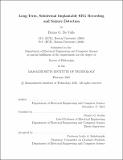Long-term, subdermal implantable EEG recording and seizure detection
Author(s)
Do Valle, Bruno Guimaraes
DownloadFull printable version (32.06Mb)
Other Contributors
Massachusetts Institute of Technology. Department of Electrical Engineering and Computer Science.
Advisor
Charles G. Sodini.
Terms of use
Metadata
Show full item recordAbstract
Epilepsy is a common chronic neurological disorder that affects about 1% of the world population. Although electroencephalogram (EEG) has been the chief modality in the diagnosis and treatment of epileptic disorders for more than half a century, long-term recordings (more than a few days) can only be obtained in hospital settings. Many patients, however, have intermittent seizures occurring far less frequent. Patients cannot come into the hospital for weeks on end in order for a seizure to be captured on EEG-a necessary prerequisite for making a definitive diagnosis, tailoring therapy, or even establishing the true rate of seizures. This work aims to address this need by proposing a subdermal implantable, eight-channel EEG recorder and seizure detector that has two modes of operation: diagnosis and seizure counting. In the diagnosis mode, EEG is continuously recorded with a 500 Hz bandwidth. This bandwidth is five times higher than typically done to record high-frequency oscillations, which, according to recently published research, may aid in the diagnosis of epilepsy. In the seizure counting mode, the system uses a novel low-power algorithm to track the number of seizures a patient has, providing doctors with a reliable count to help determine medication efficacy. This mode is especially important given the severity of antiepileptic drugs' side-effects. An ASIC that implements the EEG recording and seizure detection algorithm was designed and fabricated in a 0.18 [mu]m CMOS process. The ASIC includes eight EEG channels and was designed to minimize the system's power and size. The result is a power-efficient analog front end that requires 2.75 [mu]W per channel in diagnosis mode and 0.84 [mu]W per channel in seizure counting mode. Both modes have an input-referred noise of approximately 1.1 [mu]Vrms. The seizure detection algorithm has a sensitivity of 98.5%, a false alarm rate of 4.4 per hour, and a detection delay of 9.1 seconds. It consumes only 0.45 [mu]W, which is over an order of magnitude less power than comparable algorithms.
Description
Thesis: Ph. D., Massachusetts Institute of Technology, Department of Electrical Engineering and Computer Science, 2016. This electronic version was submitted by the student author. The certified thesis is available in the Institute Archives and Special Collections. Cataloged from student-submitted PDF version of thesis. Includes bibliographical references (pages 151-156).
Date issued
2016Department
Massachusetts Institute of Technology. Department of Electrical Engineering and Computer SciencePublisher
Massachusetts Institute of Technology
Keywords
Electrical Engineering and Computer Science.